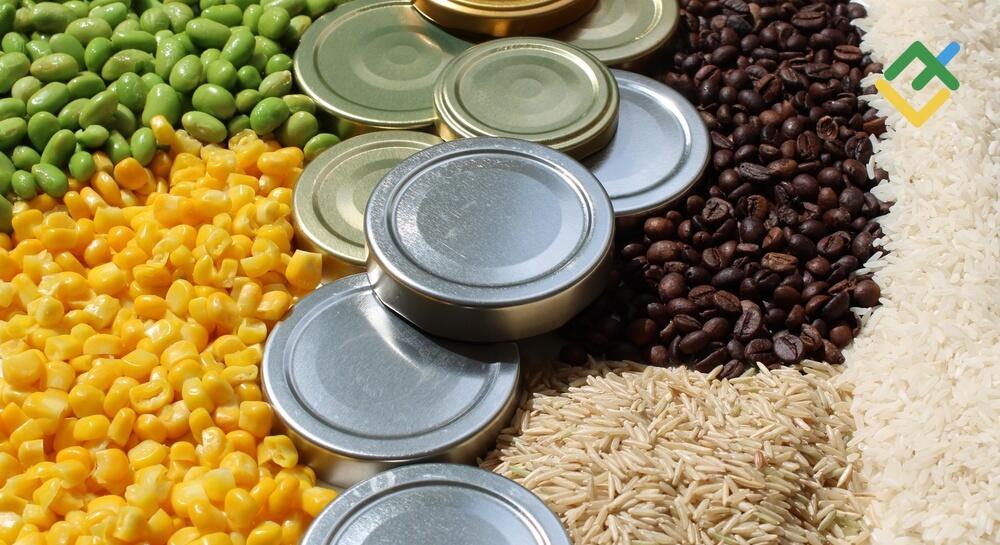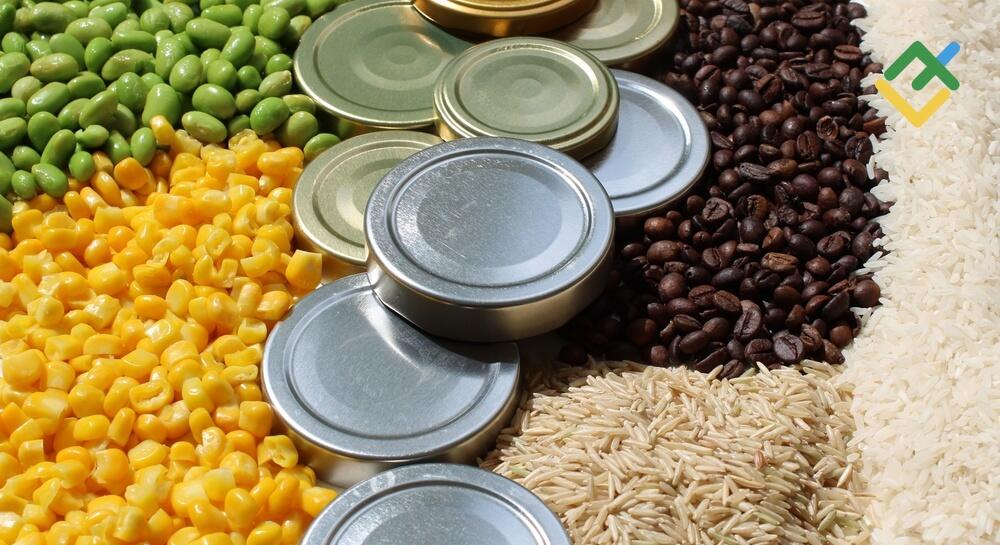Most Traded Commodities in the World 2025: Top by Volume & Value

Commodity trading on exchanges, in essence, revolves around long-term investment strategies. However, the most popular commodities are highly liquid and suitable for intraday trading or even scalping. At present, the world’s highly sought-after commodities allow traders with any amount of capital to earn on price differences.
The most popular commodities include energy, industrial, and agricultural products, as well as metals. These commodities allow you to earn money on any time frame. They can generate about 15–20% of profits. You can learn more about how to trade commodities in the live market in this article.
The article covers the following subjects:
Major Takeaways
|
What is a commodity? |
Commodity assets are a class of trading instruments based on raw materials or food products. The main difference between a commodity asset and a currency asset is that the former represents a physical and tangible raw material. |
|
Main commodities |
Commodities can include oil, gas, industrial and precious metals, as well as food products, of which the main ones are cocoa, coffee, tea, soybeans, and wheat. |
|
Why has commodities trading become so popular? |
Trading on the commodity market is popular because these trading instruments are relatively predictable. The price of major commodities tends to correlate with inflation indicators and is heavily dependent on fundamental factors, which makes forecasting much easier. |
|
How to trade commodities? |
Commodity trading is available both in physical form and in the form of standardized contracts. If a trader is not interested in the delivery of actual goods, they can purchase contracts for difference (CFD) and earn money on price swings. |
|
Which commodities are the most popular? |
The most popular commodities on the exchange are crude oil, gold, and natural gas. Among agricultural commodities, soybeans, wheat, sugar, coffee, and cocoa stand out. |
|
In which markets are commodities traded? |
Commodity trading is usually held either on an international commodity exchange or in the OTC market. The largest trading volume can be observed on the NYMEX, ICE, LME, and TOCOM exchanges. |
|
Pros and cons of commodity trading |
The main advantage of trading commodities is the guarantee of trade execution and risk insurance. On the other hand, the disadvantages of such trading are high risks, low leverage, high commissions, and taxes. |
|
Specifics of trading CFDs on commodities |
Forex brokers offer commodity trading through CFDs. In this case, the trader only receives the difference between the purchase and sale prices, but does not obtain the physical commodity. |
|
Risks of commodity trading |
The main risks when trading commodities are the basic risks associated with CFD trading. These include high price volatility, low awareness of commodity pricing, and a high probability of incurring losses. |
What Are the Most Traded Commodities in the World?
Commodity trading plays a crucial role in the world trade system, as there will always be demand for these commodities, and this demand is growing every year. These commodities also represent a significant part of the global manufacturing industry, and the stability of the global economy would be impossible without them.
- Energy commodities. Energy commodities have been firmly in the lead on commodity exchanges in terms of trading volume, as in addition to standard transactions for the supply of oil, gas, gasoline, coal, and other fuels, transactions involving them are also of interest to traders. Today, the volume of transactions with contracts for these commodities far exceeds the quantity of the commodities themselves.
- Precious and non-ferrous metals. When it comes to metals, everyone immediately thinks of gold. Gold is the most popular metal in the world and the primary store of value. However, in addition to gold, a significant portion of trading volume is concentrated on other metals, such as silver, copper, platinum, palladium, aluminum, nickel, and others.
- Grain and food commodities. These are the most popular agricultural and food products, such as wheat, corn, soybeans, sugar, coffee, tea, cocoa, potatoes, and many others.
Top Most Traded Commodities by Volume and Value
While a wide range of commodities is traded on exchanges, the most valuable ones stand out in terms of volume and liquidity. It is now virtually impossible to find a contract for such important and valuable commodities as lumber or spices. At the same time, contracts for oil or gold are available in almost all global markets and can be traded through most brokers. The following is a list of the highly traded commodities:
1. Crude Oil: The Most Traded Commodity in the World
Crude oil is the top-selling commodity, and its dominant position is a result of the significant volume of physical deliveries. Oil is the primary source of fuel for transportation, industry, and power generation. Despite efforts to transition to green energy, global demand for oil remains high. According to the International Energy Agency, global supplies reached 102.9 million barrels per day in 2024.
Oil trading occurs in two primary forms: physical deliveries and derivative financial instruments. Most exchanges feature a wide range of oil contracts, with the majority linked to the location and type of production. The most widely traded contracts are for the benchmark UK Brent crude oil and North American WTI grades.
2. Gold: Most Valuable Commodity for Trading
While oil ranks first in the world in terms of physical supply, gold trading is the global leader in exchange-traded contracts. Gold is a global commodity equivalent against which all world currencies are valued. Throughout history, gold has been considered the main measure of wealth and prosperity, and it is for this reason that the volume of gold trading grows year after year.
As a rule, gold is represented on the exchange in the form of physical bullion of various weights and standardized contracts, from futures to options. Investing in gold exchange-traded funds (ETFs) is also a very popular option.
Gold’s prevalence in exchange trading can be attributed to its status as the world’s primary safe-haven asset. In terms of exchange rates, the value of gold is inversely proportional to the risk involved. Since ancient times, a constant rule has governed the stock market: In times of global uncertainty and significant geopolitical events, buy gold as it has historically served as a reliable asset. This approach remains a valid and effective strategy today. In the current global economic uncertainty, the price of gold continues to surge.
3. Natural Gas: Essential Energy Commodity
Natural gas is another world’s major energy commodity. Gas is mainly traded through physical deliveries, but in recent years, standardized gas contracts have become a popular means of investment. Natural gas is a valuable commodity used for electricity generation, household heating, industry, and transportation.
The ever-growing demand for natural gas worldwide has led to its increasing popularity as an exchange-traded investment vehicle. According to forecasts by the International Gas Union, global natural gas consumption will increase by another 2.3%–2.5% in 2025. The situation with constantly growing demand for gas supplies has been observed for several years in a row, which attracts investors and speculators.
4. Silver: Top Traded Precious Metal
Silver is also highly popular in the global commodity market. Silver is a precious metal that is most often found in nature as a by-product of the extraction of other metal ores. Since it is rarely mined in its pure form, silver is not as popular as gold. Nevertheless, silver is the second most widely traded precious metal after gold.
Silver is mainly used in industry, in the production of electronics and medical equipment. However, silver is also used in jewelry. In investments, silver has gained popularity in the form of investment coins, which, due to their low cost, are often an alternative to gold coins. Silver ETFs and derivative contracts such as futures and options are also gaining popularity.
5. Copper: Most Traded Industrial Metal
Copper rightfully occupies a leading position among industrial metals due to its unique properties: high electrical and thermal conductivity, and resistance to corrosion. In nature, copper exists in the form of compounds with various impurities, the most common of which is sulfur. Copper has found wide application in industry, where it is used in the manufacture of electrical cables and automobiles.
In commodity markets, copper trading is popular in the form of contracts with physical deliveries, as well as in the form of derivative instruments: futures, CFDs, options, forwards, and others. The liquidity of copper trading on the exchange is quite high, and the most popular trading platforms are the Comex in the US and the LME in London.
6. Wheat: Largest Traded Agricultural Commodity
Wheat is the undisputed leader among agricultural products. On global commodity exchanges, wheat is traded in the form of futures contracts. These contracts are standardized in terms of the quantity of goods to be delivered, a fixed delivery price, and a predetermined date. There are two types of wheat futures: delivery and non-delivery (settlement). A delivery contract involves the physical delivery of goods to the buyer, while a non-delivery contract only involves a cash settlement without actual delivery.
The standard contract size for wheat is 5,000 bushels. The most popular markets for trading commodity futures are the CBOT in Chicago, the KCBT in Kansas City, and the MGEX commodity market in Minneapolis.
7. Soybeans: Best Agricultural Commodity to Trade
As with wheat, soybeans are traded on commodity markets in the form of soybean futures contracts. However, it is the no-delivery soybean contracts that are most popular with investors and speculators. The fact is that the market volatility of trading these contracts is so high that it sometimes rivals that of currency pairs, which attracts many retail traders. Similar to wheat, soybeans are traded in bushels, which equals 25.4 kilograms, and a standard contract is 5,000 bushels. Notably, soybeans are crucial for meeting global food demand.
Soybean trading is among the most traded commodities globally due to the small number of price drivers, the main ones being seasonal demand, the trade policies of major exporters and importers, and supply and demand levels. The largest trading volumes for soybean futures are observed on the Chicago Board of Trade (CBOT).
8. Corn: Top Traded Grain Commodity
Corn is a key commodity in global trade. Like other commodity instruments, corn is traded on exchanges in the form of futures, which involve both physical delivery and non-delivery. The main trading platform for corn futures is the Chicago Board of Trade (CBOT), where this instrument has the ZC ticker.
Contracts are divided into two main types based on volume: standard contracts and mini contracts. The standard volume includes 5,000 bushels, and the mini contract consists of 1,000 bushels. The decision to introduce mini futures was made to increase the availability of the commodity for trading to investors with small amounts of capital. It is no secret that leverage is limited on the commodity exchange, and traders with small capital cannot afford standard contracts. On average, one mini contract costs a trader $1.25, which makes it more accessible to all categories of traders.
9. Coffee: Most Traded Commodity
Among basic commodities, coffee is the most popular. Coffee is traded as futures on two main types of coffee beans: Arabica and Robusta. Arabica is the most expensive variety, accounting for 60% to 70% of total global coffee production. Robusta beans are less in demand on the exchange, and therefore their price is significantly lower than that of Arabica.
The key marketplace for trading coffee bean futures is the Intercontinental Exchange (ICE) in the US, where Arabica contracts are traded. Robusta is traded mainly on the London International Financial Futures and Options Exchange (LIFFE). Futures for both types of coffee are traded on the Tokyo Grain Exchange (TGE).
10. Sugar: Highest Volume Soft Commodity
Sugar is a commodity asset also known for its high trading volume. As with all commodity assets, the key contract is futures for several types of sugar. The most commonly traded futures are No. 11 and No. 16, representing futures contracts for the physical delivery of raw cane sugar. The second most popular is white sugar, or No. 407. The unit of measurement for No. 11 and No. 16 sugar contracts is pounds, while white sugar No. 407 is traded in tons.
The main trading platform for sugar No. 11 and No. 16 is the Intercontinental Exchange (ICE) in New York. Trading in white sugar No. 407 is mainly carried out on the London International Financial Futures and Options Exchange (LIFFE). The Zhengzhou Commodity Exchange (ZCE) also trades white sugar contracts. Notably, sugar futures are often traded in national currencies, and trading in dollars only takes place on the ICE.
Best Commodities to Trade: Most Valuable Investment
When it comes to trading, the first thing that comes to mind is speculative transactions with derivative contracts, such as futures or CFDs. Based on this, the list of possible options narrows down to highly liquid commodities: oil and gold.
The Best Commodity for Trading — Oil
Oil is the most liquid commodity, and for this reason, fluctuations in its price can lead to both quick profits and losses. To ensure your oil trades are successful, you need to understand the characteristics of this asset and the principles of pricing.
The key factors in oil pricing are the balance of supply and demand. As a rule, if global demand for oil is growing and production levels are falling or remaining unchanged, the price of the asset will rise. If demand for oil declines, a downward trend will prevail. This is precisely why oil prices react so strongly to the weekly statistics on US oil reserves.
However, the first place in the world in terms of trading volume is rightfully held by the arbitrage on the Brent/WTI price difference. This position is often referred to as a spread, as traders essentially compare the prices of these grades and bet on the difference widening or narrowing.
The World’s Largest Traded Commodity — Gold
Gold is another popular instrument among traders. Gold contracts are now offered by virtually every broker in almost every corner of the world. Futures contracts are popular on major exchanges, while CFDs on commodities are offered by most Forex brokers.
Gold pricing is mainly influenced by geopolitical tensions and demand for physical gold. The price of gold is an excellent indicator of uncertainty and turmoil. When there is significant turbulence in the global political and economic landscape, the gold price rises as traders mitigate the risks of investing in other assets and reallocate their money to gold. Another important factor in the precious metal’s pricing is the demand for gold bullion. Central banks around the world hold part of their reserves in gold and buy the precious metal. When the volume of these purchases begins to grow, gold also tends to surge in price.
How to Trade Commodities
Trading commodities on the exchange is not complicated. First, it is necessary to determine the correct sequence of your actions.
- Define your investment goal. To choose the most profitable commodity market to trade on, you need to understand your needs. If you have a business and are interested in actual goods, you need to gain access to the commodity exchange where the commodities you need are traded. If you want to earn on the price difference without receiving actual deliveries, contracts for difference would be a suitable option.
- Open a trading account with a broker. Different brokers offer various terms and conditions, and to minimize risks and losses, you need to choose a broker that provides a full range of commodity contracts you need without excessive commissions.
- Choose a trading strategy. Although commodity assets differ from currency pairs, their charts look the same on the broker’s trading platform. Therefore, all trading strategies based on technical analysis will work for commodities as well.
- Study the contract specifications. Carefully read the contract specifications provided by the broker, especially if you are going to invest rather than speculate intraday. For long-term investments, daily swaps are crucial; if the swap is negative, you need to understand how much interest you will pay on your open position.
- Strive for your goal and do not get distracted by market noise. This step is more applicable to long-term strategic trades, as these are the trades that can bring the most profit when dealing with commodity assets.
- Diversify your portfolio. The saying that you should not put all your eggs in one basket is especially true in the commodity market. All commodity assets are interconnected; diversifying investments across three to five instruments can safeguard against potential risks while potentially offering enhanced returns.
Conclusion
Сommodity trading is quite popular among traders with small amounts of capital. However, beginners often choose gold contracts, which are highly volatile. As a rule, this leads to disappointing results. Any commodity asset is a complex instrument, and before trading, it is necessary to understand what makes its price fluctuate.
Commodity futures contracts can bring more profit, but trading them requires skills and knowledge. Such contracts can be used as a way of running a business, reducing the cost of purchasing raw materials. You can also create hedging structures in which one commodity is offset by another, which will reduce your potential risks to almost zero.
Most Traded Commodities FAQs
The content of this article reflects the author’s opinion and does not necessarily reflect the official position of LiteFinance broker. The material published on this page is provided for informational purposes only and should not be considered as the provision of investment advice for the purposes of Directive 2014/65/EU.
According to copyright law, this article is considered intellectual property, which includes a prohibition on copying and distributing it without consent.






